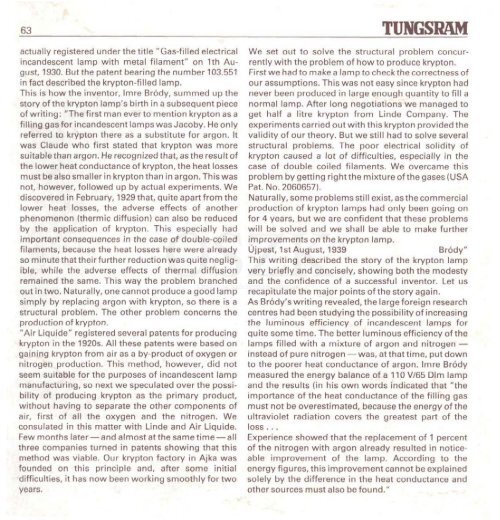THE HISTORY OF TUNGSRAM 1896-1945 - MEK
THE HISTORY OF TUNGSRAM 1896-1945 - MEK
THE HISTORY OF TUNGSRAM 1896-1945 - MEK
- No tags were found...
Create successful ePaper yourself
Turn your PDF publications into a flip-book with our unique Google optimized e-Paper software.
63 <strong>TUNGSRAM</strong>actually registered under the title "Gas-filled electricalincandescent lamp with metal filament" on 1th August,1930. But the patent bearing the number 103.551in fact described the krypton-filled lamp.This is how the inventor, Imre Brody, summed up thestory of the krypton lamp's birth in a subsequent pieceof writing: "The first man ever to mention krypton as afilling gas for incandescent lamps was Jacoby. He onlyreferred to krypton there as a substitute for argon. Itwas Claude who first stated that krypton was moresuitable than argon. He recognized that, as the result ofthe lower heat conductance of krypton, the heat lossesmust be also smaller in krypton than in argon. This wasnot, however, followed up by actual experiments. Wediscovered in February, 1929 that, quite apart from thelower heat losses, the adverse effects of anotherphenomenon (thermic diffusion) can also be reducedby the application of krypton. This especially hadimportant consequences in the case of double-coiledfilaments, because the heat losses here were alreadyso minute that their further reduction was quite negligible,while the adverse effects of thermal diffusionremained the same. This way the problem branchedout in two. Naturally, one cannot produce a good lampsimply by replacing argon with krypton, so there is astructural problem. The other problem concerns theproduction of krypton."Air Liquide" registered several patents for producingkrypton in the 1920s. All these patents were based ongaining krypton from air as a by-product of oxygen ornitrogen production. This method, however, did notseem suitable for the purposes of incandescent lampmanufacturing, so next we speculated over the possibilityof producing krypton as the primary product,without having to separate the other components ofair, first of all the oxygen and the nitrogen. Weconsulated in this matter with Linde and Air Liquide.Few months later — and almost at the same time — allthree companies turned in patents showing that thismethod was viable. Our krypton factory in Ajka wasfounded on this principle and, after some initialdifficulties, it has now been working smoothly for twoyears. ., , ,., .,^„^:We set out to solve the structural problem concurrentlywith the problem of how to produce krypton.First we had to make a lamp to check the correctness ofour assumptions. This was not easy since krypton hadnever been produced in large enough quantity to fill anormal lamp. After long negotiations we managed toget half a litre krypton from Linde Company. Theexperiments carried out with this krypton provided thevalidity of our theory. But we still had to solve severalstructural problems. The poor electrical solidity ofkrypton caused a lot of difficulties, especially in thecase of double coiled filaments. We overcame thisproblem by getting rightthe mixture of the gases (USAPat. No. 2060657).Naturally, some problems still exist, as the commercialproduction of krypton lamps had only been going onfor 4 years, but we are confident that these problemswill be solved and we shall be able to make furtherimprovements on the krypton lamp.Ujpest, 1 St August, 1939Brody"This writing described the story of the krypton lampvery briefly and concisely, showing both the modestyand the confidence of a successful inventor. Let usrecapitulate the major points of the story again.As Brody's writing revealed, the large foreign researchcentres had been studying the possibility of increasingthe luminous efficiency of incandescent lamps forquite some time. The better luminous efficiency of thelamps filled with a mixture of argon and nitrogen —instead of pure nitrogen — was, at that time, put downto the poorer heat conductance of argon. Imre Brodymeasured the energy balance of a 110 V/65 Dim lampand the results (in his own words indicated that "theimportance of the heat conductance of the filling gasmust not be overestimated, because the energy of theultraviolet radiation covers the greatest part of theloss . . .Experience showed that the replacement of 1 percentof the nitrogen with argon already resulted in noticeableimprovement of the lamp. According to theenergy figures, this improvement cannot be explainedsolely by the difference in the heat conductance andother sources must also be found."








![Letöltés egy fájlban [4.3 MB - PDF]](https://img.yumpu.com/50159926/1/180x260/letaltacs-egy-fajlban-43-mb-pdf.jpg?quality=85)







